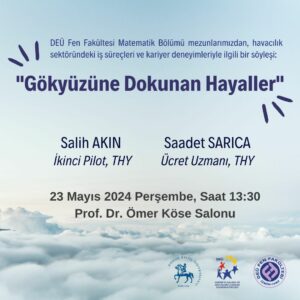Prof. Dr. Feryal Alayont, Mathematics at Grand Valley State University
Date: May 16, 2024, Thursday
Time: 11:00 am
Place: B257, Faculty of Science, Dokuz Eylül University
Abstract: An edge cover of a simple graph is a subset of the edges so that each vertex is incident with at least one edge in the subset. The edge cover polynomial of a graph is the generating polynomial of the number of edge covers of the graph. Specifically, the edge cover polynomial is defined as where is the number of edge covers with edges. The edge cover polynomials of path and cycle graphs are known to have real roots, and hence have log-concave and unimodal coefficients. In this talk, we will describe how to construct other graph families whose edge cover polynomials have real roots and some whose polynomials have non-real roots, but still have log- concave and unimodal coefficients. This is joint work with Evan Henning and Can Selek.
Feryal Alayont is a Professor of Mathematics at Grand Valley State University. She received her B.S. in mathematics from Bilkent University, Turkey, and her Ph.D. in mathematics from the University of Minnesota. She was a teaching postdoctoral fellow at the University of Arizona from 2003 to 2006. Since 2006, she has been at Grand Valley State University in the Department of Mathematics, where she also served as the Mathematics Advising and Engagement Coordinator from 2016-2022. She is an active undergraduate research mentor and has mentored more than 75 students at GVSU. Her research interests include enumerative combinatorics, graph theory, ethics in mathematics, and the scholarship of teaching of mathematics.
